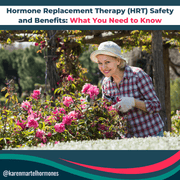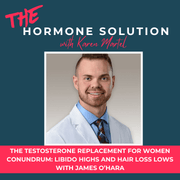Hormonal production continues to decline into the ’40s until menstrual cycles end, generally in the ’50s; the average age in the United States is 51. Women can spend 8-12 years in perimenopause and roughly 75 percent of women will present with many or all of the previously mentioned symptoms. Bear in mind that the physical discomfort of hot flashes, night sweats, irritability, poor sleep, and brain fog are accompanied by internal metabolic chaos, insulin resistance, weight-loss resistance, high cholesterol, high blood pressure, decreasing bone mineral density, allergies, and lowered immunity which causes a host of other problems that many doctors will prescribe medication for that do not address the root of the problem, reduction and loss of hormonal production.
Early perimenopausal intervention can include lowering stress, dietary supplements, and a hormone-balancing diet and some women will find that works well for a few years and they can maintain a good quality of life. However, when symptoms start to increase and the supplements stop working as well as they used to, that is a sign that ovarian function is declining. At that point, no amount of supplementation or dieting will revive the ovaries. It is a good time to have hormones tested to check levels (saliva and urine are most accurate but serum can be used as well) and if numbers are within a certain range, you can begin replacing your hormones.
It is important to pay attention to your body and keep track of your symptoms and any other changes that will indicate a need to adjust dosing to keep up with the body’s decline. When it comes to hormonal replacement therapy, there is not a one size fits all or a one-time dose that is good forever. Adjusting as you go along will help you maintain the appropriate amount as you age. It is a common belief the lowest amount that will relieve symptoms. However, physiologic dosing will relieve symptoms and provide the protective health benefits hormones offer.
How Long Can Someone Stay on BHRT? It appears that BHRT taken within the first 10 years of menopause is optimal, between 51-61 years of age. Dr. Shelly Salpeter was one of the first scientists to discover this. But taking BHRT earlier, during perimenopause, is even better. If you are interested in starting BHRT and you are beyond the 10-year mark, it is still possible to get the health benefits. The key is to start at a very low dose and increase very slowly. After 10 years post menopause, hormone receptors go dormant or “fall asleep”. Gently “awakening” the hormone receptors slowly will prevent shocking and stressing the body.
A healthy older woman who works with her doctor to replace hormones in a slow and low-dose manner can do so safely and still get the health benefits. Much of the research done on long term HRT was done on oral HRT – Premarin and progestins together – which, as discussed is the most toxic form of hormone replacement that led to breast cancer and uterine cancer.
After 10 years post menopause, studies have shown a very small increase in risk of heart attack and stroke in some women taking hormone replacement. This is why many believe that a 10-year window from the onset of menopause is the safest and most beneficial. Yet the study from the University of Arizona mentioned earlier that BHRT taken 6 yearsor longer reduces Alzheimer's and dementia by 75%. Using transdermal BHRT for longer periods of time seems to be safer.
Next The Benefits of BHRT.
Do you want to know more about how to replace your hormones safely? Check myOnTrack women's membership program that teaches you everything you need to know about replacing your own hormones.














